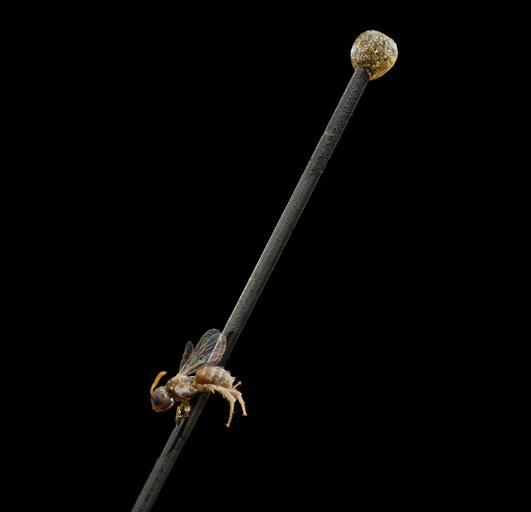MAKE A MEME
View Large Image

| View Original: | Chiasmognathus_cf_gussakovskii,_u,_tadjikistan,_sidefar_2014-11-01-20.20.02_ZS_PMax.jpg (3749x3617) | |||
| Download: | Original | Medium | Small | Thumb |
| Courtesy of: | www.flickr.com | More Like This | ||
| Keywords: chiasmognathus taxonomy:genus=chiasmognathus apidae apoidea hymenoptera nomioides tajikistan insect pin insectpin glue nest parasite nestparasite parasite tiny bee tinybee mini-bee minibee asia near east neareast droege biml usgsbiml usgs black background minimalism Chiasmognathus c.f. gussakovskii, Cross Mandibled Bee, specimen collected by Wojciech Pulawksi in Tajikistan Very small bees have very small nest parasites. In this case the very small mini-bees in the genus Nomioides (see account XXX) which do collect pollen and nectar, also have their very own super small (2-4mm) mini-mini-bees that raid their nests and leave eggs behind to hatch, kill the host’s larvae and live off the left-behind supplies. The Cross Mandibled Bee is so named for the unusual position of its mandibles in cross-wise fashion rather than the usual bee model of simply overlapping towards the tips. It is unclear what the use of the mandibles in these positions might be. Cross Mandibled Bees are difficult to find, they spend little time on flowers , are, as was mentioned, incredibly tiny and usually can only be found near the nests of their host, which are also difficult to find, where they fly around looking for access to nests. Thus our expectation is that over time and, as people look for these things, more nests of Nomioides will be found and with that, more Cross Mandibled Bees. Indeed, since they were first recognized as attacking their specific Nomioides hosts, new species of Cross-Mandibled bees have been found every year and they are now known from the Mediterranean, Central Asia, the Arabian Peninsula, Sri Lanka and both Western and Eastern Africa – though the species from the latter region have not yet been formally described. ~~~~~~~~~~{{{{{{0}}}}}}~~~~~~~~~~ All photographs are public domain, feel free to download and use as you wish. Photography Information: Canon Mark II 5D, Zerene Stacker, Stackshot Sled, 65mm Canon MP-E 1-5X macro lens, Twin Macro Flash in Styrofoam Cooler, F5.0, ISO 100, Shutter Speed 200 Further in Summer than the Birds Pathetic from the Grass A minor Nation celebrates Its unobtrusive Mass. No Ordinance be seen So gradual the Grace A pensive Custom it becomes Enlarging Loneliness. Antiquest felt at Noon When August burning low Arise this spectral Canticle Repose to typify Remit as yet no Grace No Furrow on the Glow Yet a Druidic Difference Enhances Nature now -- Emily Dickinson Want some Useful Links to the Techniques We Use? Well now here you go Citizen: Basic USGSBIML set up: www.youtube.com/watch?v=S-_yvIsucOY USGSBIML Photoshopping Technique: Note that we now have added using the burn tool at 50% opacity set to shadows to clean up the halos that bleed into the black background from "hot" color sections of the picture. www.youtube.com/watch?v=Bdmx_8zqvN4 PDF of Basic USGSBIML Photography Set Up: ftp://ftpext.usgs.gov/pub/er/md/laurel/Droege/How%20to%20Take%20MacroPhotographs%20of%20Insects%20BIML%20Lab2.pdf Google Hangout Demonstration of Techniques: plus.google.com/events/c5569losvskrv2nu606ltof8odo or www.youtube.com/watch?v=4c15neFttoU Excellent Technical Form on Stacking: www.photomacrography.net/ Contact information: Sam Droege sdroege@usgs.gov 301 497 5840 Chiasmognathus c.f. gussakovskii, Cross Mandibled Bee, specimen collected by Wojciech Pulawksi in Tajikistan Very small bees have very small nest parasites. In this case the very small mini-bees in the genus Nomioides (see account XXX) which do collect pollen and nectar, also have their very own super small (2-4mm) mini-mini-bees that raid their nests and leave eggs behind to hatch, kill the host’s larvae and live off the left-behind supplies. The Cross Mandibled Bee is so named for the unusual position of its mandibles in cross-wise fashion rather than the usual bee model of simply overlapping towards the tips. It is unclear what the use of the mandibles in these positions might be. Cross Mandibled Bees are difficult to find, they spend little time on flowers , are, as was mentioned, incredibly tiny and usually can only be found near the nests of their host, which are also difficult to find, where they fly around looking for access to nests. Thus our expectation is that over time and, as people look for these things, more nests of Nomioides will be found and with that, more Cross Mandibled Bees. Indeed, since they were first recognized as attacking their specific Nomioides hosts, new species of Cross-Mandibled bees have been found every year and they are now known from the Mediterranean, Central Asia, the Arabian Peninsula, Sri Lanka and both Western and Eastern Africa – though the species from the latter region have not yet been formally described. ~~~~~~~~~~{{{{{{0}}}}}}~~~~~~~~~~ All photographs are public domain, feel free to download and use as you wish. Photography Information: Canon Mark II 5D, Zerene Stacker, Stackshot Sled, 65mm Canon MP-E 1-5X macro lens, Twin Macro Flash in Styrofoam Cooler, F5.0, ISO 100, Shutter Speed 200 Further in Summer than the Birds Pathetic from the Grass A minor Nation celebrates Its unobtrusive Mass. No Ordinance be seen So gradual the Grace A pensive Custom it becomes Enlarging Loneliness. Antiquest felt at Noon When August burning low Arise this spectral Canticle Repose to typify Remit as yet no Grace No Furrow on the Glow Yet a Druidic Difference Enhances Nature now -- Emily Dickinson Want some Useful Links to the Techniques We Use? Well now here you go Citizen: Basic USGSBIML set up: www.youtube.com/watch?v=S-_yvIsucOY USGSBIML Photoshopping Technique: Note that we now have added using the burn tool at 50% opacity set to shadows to clean up the halos that bleed into the black background from "hot" color sections of the picture. www.youtube.com/watch?v=Bdmx_8zqvN4 PDF of Basic USGSBIML Photography Set Up: ftp://ftpext.usgs.gov/pub/er/md/laurel/Droege/How%20to%20Take%20MacroPhotographs%20of%20Insects%20BIML%20Lab2.pdf Google Hangout Demonstration of Techniques: plus.google.com/events/c5569losvskrv2nu606ltof8odo or www.youtube.com/watch?v=4c15neFttoU Excellent Technical Form on Stacking: www.photomacrography.net/ Contact information: Sam Droege sdroege@usgs.gov 301 497 5840 | ||||